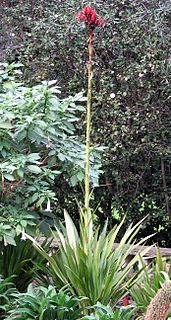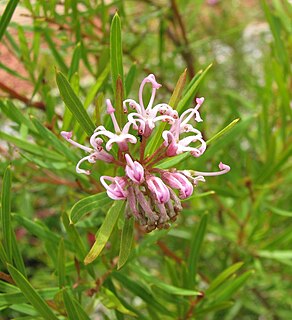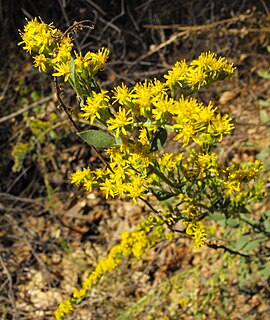
Doryanthes excelsa, commonly known as the gymea lily, is a flowering plant in the family Doryanthaceae that is endemic to coastal areas of New South Wales near Sydney. It has sword-like leaves more than 1 metre (3 ft) long and it grows a flower spike up to 6 metres (20 ft) high. The apex of the spike bears a large cluster of bright red flowers, each 10 centimetres (4 in) across. Its common name is derived from the name given to the plant by the indigenous Eora people. The Sydney suburbs of Gymea and Gymea Bay are named after the lily.

Grevillea sericea, commonly known as the pink spider flower, is a shrub endemic to New South Wales, Australia.

Campanula rapunculus, common name rampion bellflower, rampion, rover bellflower, or rapunzel, is a species of bellflower (Campanula) in the family Campanulaceae.

Protea aristata is a compact shrub with beautiful flowers which is endemic to the southwestern part of the Cape Region of South Africa. P. aristata has become one of South Africa's most famous proteas in spite of its relatively late discovery, and re-discovery in 1953. The leaves are soft, dense and needle-like and the flower heads are a stunning crimson red, it may thus be a good potential ornamental plant for South African gardens. It is usually called the Ladismith sugarbush in South African English, although it has been called pine sugar bush in Australia. In the Afrikaans language it has the vernacular name of klein-den-suikerbos.

Arctostaphylos insularis is a species of manzanita known by the common name island manzanita. It is endemic to Santa Cruz Island, one of the Channel Islands of California.
Arctostaphylos luciana is a species of manzanita known by the common name Santa Lucia manzanita, is endemic to California. .

Lycium brevipes is a species of flowering plant in the nightshade family known by the common name Baja desert-thorn. It is native to northwestern Mexico and it occurs in California as far as the Sonoran Desert as well as some of the Channel Islands. It grows in the scrub of desert and coastline. It is also used as a southwestern landscaping plant. This is a bushy, spreading shrub approaching a maximum height of 4 metres (13 ft) with many long, thorny, tangled branches. The branches are lined with small, fleshy green leaves up to 1.5 centimetres (0.59 in) long and coated with glandular hairs. The inflorescence is a small cluster of tubular flowers roughly 1–2 centimetres (0.39–0.79 in) long including the calyx of sepals at the base. The lavender to nearly white corolla is funnel-shaped and has 2 to 6 lobes at the mouth. The five stamens and one style protrude from the flower. The fruit is a bright red spherical berry about a centimeter wide containing many seeds. The berries attract birds.

Lycium cooperi is a species of flowering plant in the nightshade family known by the common name peach thorn. It is native to the southwestern United States, where it grows in a variety of desert and mountain habitat types. This is a bushy, erect shrub approaching a maximum height of 4 metres (13 ft) with many rigid, thorny branches. The branches are lined thickly with fleshy oval or widely lance-shaped leaves each 1–3 centimetres (0.39–1.18 in) long and coated with glandular hairs. The inflorescence is a small cluster of tubular flowers roughly 1–2 centimetres (0.39–0.79 in) long including the calyx of fleshy sepals at the base. The flower is white or greenish with lavender or green veining. The corolla is a tube opening into a face with four or five lobes. The fruit is a yellow or orange berry under a centimeter wide containing many seeds.
Perideridia bacigalupii is an uncommon species of flowering plant in the family Apiaceae known by the common names Mother Lode yampah and Bacigalupi's perideridia. It is endemic to California, where it is known only from the northern and central Sierra Nevada foothills. It is a member of the flora in chaparral and pine woodlands. It is a perennial herb which may exceed 1.5 meters in maximum height, its slender, erect stem growing from tubers. Leaves near the base of the plant have blades up to 40 centimeters long which are divided into many narrow subdivided lobes. Leaves higher on the plant are smaller and less divided. The inflorescence is a compound umbel of many spherical clusters of small white flowers. These yield ribbed, oblong-shaped fruits about half a centimeter long.

Perideridia bolanderi is a species of flowering plant in the family Apiaceae known by the common name Bolander's yampah. It is native to the western United States, where it grows in many types of habitat. It is a perennial herb which may approach one meter in maximum height, its slender, erect stem growing from tubers measuring up to 7 centimeters long. Leaves near the base of the plant have blades up to 20 centimeters long which are divided into many subdivided lobes of various sizes and shapes; the terminal segments are usually lined with teeth. Leaves higher on the plant are smaller and less divided. The inflorescence is a compound umbel of many spherical clusters of small white flowers. These yield ribbed, oblong-shaped fruits about half a centimeter long. The Atsugewi and Miwok of California used the tuberous roots of this plant for food.

Perideridia kelloggii is a species of flowering plant in the family Apiaceae known by the common name Kellogg's yampah. It is endemic to California, where it is known from the north and central coasts, the San Francisco Bay Area, and the Sierra Nevada foothills. It grows in grassland habitat, sometimes on serpentine soils. It is a perennial herb which may reach 1.5 meters in maximum height, its slender, erect stem growing from a cluster of long, narrow, fibrous roots each up to 15 centimeters long. Leaves near the base of the plant have blades up to 45 centimeters wide which are divided into many leaflets subdivided into narrow, elongated lobes. The inflorescence is a compound umbel of many spherical clusters of small white flowers. These yield ribbed, oblong-shaped fruits each about half a centimeter long.

Scrophularia lanceolata is a species of flowering plant in the figwort family known by the common names lanceleaf figwort and American figwort. It is native to North America, where it is known from western and eastern Canada and much of the United States except for the southeastern quadrant. Past common names include Western figwort when the western US plants were grouped under the name Scrophularia occidentalis and the eastern US plants were called Scrophularia leporella with the common name hare figwort.

Solidago californica is a species of goldenrod known by the common name California goldenrod.
Amsonia kearneyana is a rare species of flowering plant in the dogbane family known by the common name Kearney's bluestar. It is native to Arizona, where there is only one native population in the Baboquivari Mountains of Pima County. There may also be a population just south of the border in Sonora, Mexico. The plant was federally listed as an endangered species in 1989. At that time the global population of the plant was made up of eight individuals in a riparian canyon. Since that time the plant has been manually propagated in an attempt to increase its numbers. Threats to the tiny native population include habitat destruction from livestock activity and flash floods in the river canyon. Many of the plants cannot reproduce because their seeds are sterile and nonviable, but this is probably due to insect predation on the seeds as they develop.

Bloomeria aurea, with common name golden stars, is a species of Bloomeria that is endemic to California. When blooming in late spring, its bright colors are distinctive.

Asparagus acutifolius, common name wild asparagus, is an evergreen perennial plant belonging to the genus Asparagus. The specific epithet, acutifolius, meaning "thorny leaves", is derived from Latin acutus, and -folius (-leaved), and refers to the characteristic shape of the leaves, a quite common feature in the typical plants of the Mediterranean.

Castilleja christii is a rare species of flowering plant in the family Orobanchaceae known by the common name Christ's Indian paintbrush. It is endemic to Idaho in the United States, where there is a single population on Mount Harrison in the Albion Mountains in the Minidoka Ranger District of Sawtooth National Forest. It is one of Idaho's rarest plants.

Rheum webbianum is a species of herbaceous perennial rhubarb-relative in the family Polygonaceae from the southwestern Himalayan region, known in (Indian) English as Indian rhubarb, Gilgiti rhubarb or small Himalayan rhubarb.

Hakea eyreana, commonly known as straggly corkbark, is a tree in the family Proteacea and is endemic to arid parts of inland Australia. It has needle-shaped leaves, greenish-yellow flowers and oblong to egg-shaped fruit.
Protea decurrens, also known as linear-leaf sugarbush, is a shrub of the genus Protea, in the Proteaceae family, which is endemic to the southwestern Cape Region of South Africa. It is a small shrub with a thick underground rootstock, this structure throwing up numerous leafy branches, upon the base of which clusters of flower heads may appear close to the ground. It is pollinated by rodents and grows in low-altitude fynbos or renosterveld.















